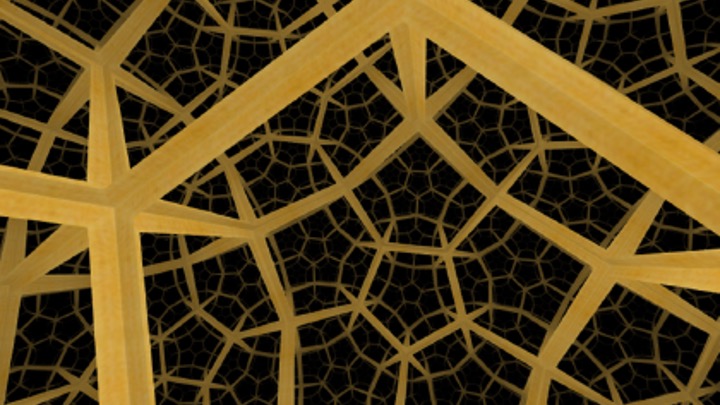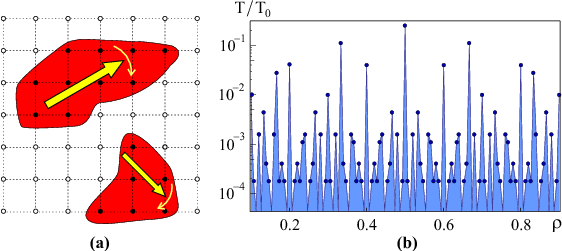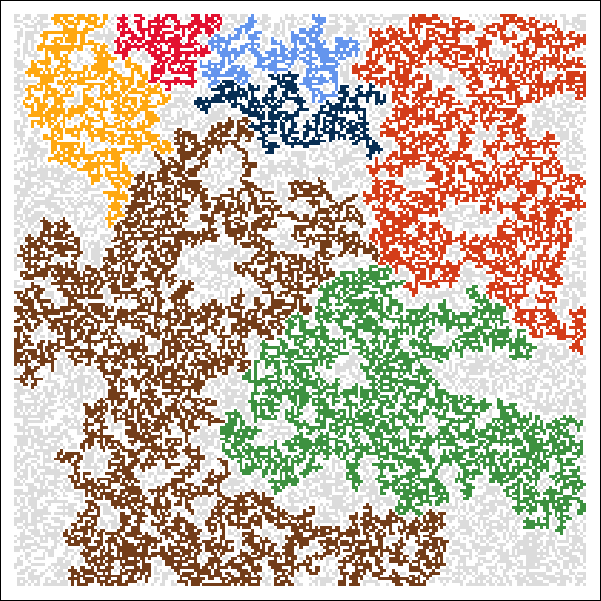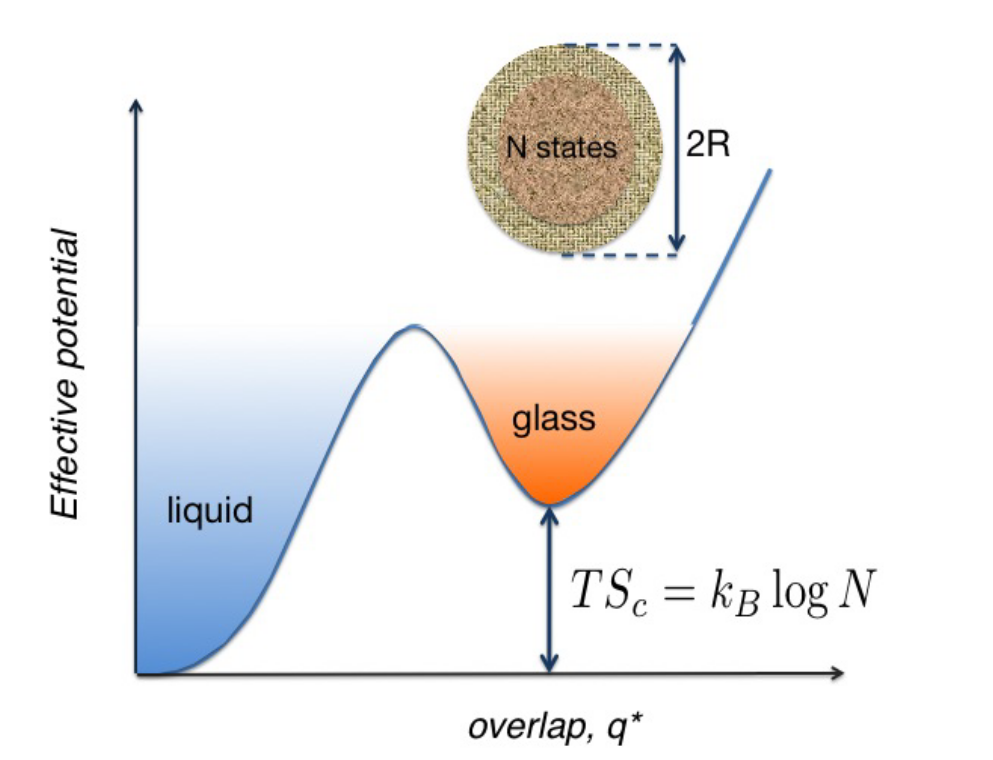Disordered systems
Complex materials are exceptionally sensitive with respect to disorder and imperfections. In some cases they can even self-generate such imperfections. For example, quantum systems in the vicinity of a quantum critical point are exceptionally sensitive to disorder. This gives rise to quantum Griffiths behavior where rare regions give rise to a singular contribution to the thermodynamic response, to novel criticality in percolating systems, to smearing of the transition and to complex-valued critical exponents. We also investigated the possibility of self-generated glass formation in systems with frustrated interactions of different length scales and determined a spectrum of exponentially many metastable states and analyzed the shapes of cooperatively rearranging regions of glass-forming liquids. In addition to the publications that are listed below, we have investigated the issue of disorder in the context of superconductors and other states of complex order. The corresponding references can be found there.
Return to the research group - strongly correlated electrons.
Selected Publications:
- Critical phenomena in hyperbolic space, K. Mnasri, B. Jeevanesan, and J. Schmalian, Physical Review B 92, 134423 (2015). Editor’s suggestion https://arxiv.org/abs/1507.02909
- Complex Critical Exponents for Percolation Transitions in Josephson-Junction Arrays, Antiferromagnets, and Interacting Bosons, R. M. Fernandes and J. Schmalian, Physical Review Letters 106, 067004 (2011). https://arxiv.org/abs/1009.2551
- Replica theory for fluctuations of the activation barriers in glassy systems, M. Dzero, J. Schmalian, and P. G. Wolynes, Physical Review B 80, 024204 (2009). https://arxiv.org/abs/0809.3988
- 7Li NMR study of heavy-fermion LiV2O4 containing magnetic defects, Zong X, Das S, Borsa F, Vannette M.D., Prozorov R. Schmalian, J., Johnston D.C., Physical Review B 77, 144419 (2008). Editor’s suggestion
- The Shapes of Cooperatively Rearranging Regions in Glass Forming Liquids, J. D. Stevenson, J. Schmalian, P. G. Wolynes, Nature Physics 4, 268 (2006). https://arxiv.org/abs/cond-mat/0507543
- Interface mobility and the liquid-Glass transition in a one–component system described by an embedded atom method potential, M. I Mendelev, J. Schmalian, C. Z. Wang, J. R. Morris, K. M. Ho, Physical Review B 74, 104206 (2006).
- Percolation quantum phase transition in diluted magnets, T. Vojta and J. Schmalian, Physical Review Letters 95, 237206 (2005). https://arxiv.org/abs/cond-mat/0508211
- Dynamics of Magnetic Defects in Heavy Fermion LiV2O4 from Stretched Exponential 7Li NMR Relaxation, D. C. Johnston, S.-H. Baek, X. Zong, F. Borsa, J. Schmalian, S. Kondo, Physical Review Letters 95, 176408 (2005).
- Comment on "Quantum Griffiths effects in metallic systems" by A. H. Castro Neto and B. A. Jones; A. J. Millis, D. K. Morr and J. Schmalian, Europhysics Letters 72, 1052 (2005).
- Activated events in glasses: the structure of entropic droplets, M. Dzero, J. Schmalian, and P. G. Wolynes, Phys. Rev. B, Rapid Communications 72, 100201 (2005). https://arxiv.org/abs/cond-mat/0502011
- Correlated disorder in random block copolymers, H. Westfahl, Jr. and J. Schmalian, Physical Review E 72, 011806 (2005). https://arxiv.org/abs/cond-mat/0501682
- Quantum Griffiths effects in itinerant Heisenberg magnets, T. Vojta and J. Schmalian, Physical Review B 72, 045438 (2005). Featured in: Virtual Journal of Nanoscale Science & Technology 12 issue 4 (2005) https://arxiv.org/abs/cond-mat/0405609
- Electronic Mayonnaise: Uniting the Sciences of "Hard" and "Soft" Matter, J. Schmalian, P. G. Wolynes, Materials Research Society, Bulletin 30, 433 (2005).
- Glassy behavior in systems with Kac-type step-function interaction, Kok-Kiong Loh, K. Kawasaki, A. R. Bishop, T. Lookman, A. Saxena, J. Schmalian, Z. Nussinov Physical Review E, Rapid Communications 69, 010501 (2004). https://arxiv.org/abs/cond-mat/0206494
- Solution of local-field equations for self-generated glasses, S. Wu, J. Schmalian, G. Kotliar, and P. G. Wolynes, Physical Review B 70, 024207 (2004). https://arxiv.org/abs/cond-mat/0305404
- Dynamical mean-field theory of quantum stripe glasses, H. Westfahl Jr., J. Schmalian, P. G. Wolynes, Physical Review B 68, 134203 (2003). https://arxiv.org/abs/cond-mat/0202099
- Quantum Griffiths effects in metallic systems, A. J. Millis, D. K, Morr, J. Schmalian, Physical Review B 66, 174433 (2002). https://arxiv.org/abs/cond-mat/0208396
- Theory of Microemulsion Glasses, S. Wu, H. Westfahl Jr., J. Schmalian, and P. G. Wolynes, Chemical Physics Letters 359, 1 (2002). https://arxiv.org/abs/cond-mat/0105308
- Local Defect in Metallic Quantum Critical Systems, A. J. Millis, D. K. Morr, J. Schmalian Physical Review Letters 87, 167202 (2001). https://arxiv.org/abs/cond-mat/0104258
- Self-generated randomness, defect wandering and viscous flow in stripe glasses, H. Westfahl Jr., J. Schmalian, P. G. Wolynes, Physical Review B 64, 174203 (2001). https://arxiv.org/abs/cond-mat/0102285
- Stripe Glasses: Self-Generated Randomness in a Uniformly Frustrated System, J. Schmalian, P. G. Wolynes, Physical Review Letters 85, 836 (2000). https://arxiv.org/abs/cond-mat/0003267




